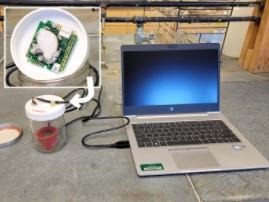
A view of the experimental site in dryland farming in eastern Montana where soil sample was collected to measure carbon dioxide flush. The research team determined that the easier and faster method of measuring carbon dioxide flush also resulted in a more reliable and useful indicator of soil health.
The researchers measured bursts of carbon dioxide gas emitted when dried soil samples are rewetted. These bursts of carbon dioxide – called carbon dioxide flush – is an indicator of soil microbial activity.
“Measuring carbon dioxide flush is simple and inexpensive,” says Upendra Sainju, lead author of the study. “We also found that carbon dioxide flush is related to several soil properties and long-term crop yields.”
Sainju believes carbon dioxide flush can be used to measure soil health and relate crop yields reliably. Currently, this method is evaluating to estimate dryland crop yields in arid and semiarid regions.
There are several advantages to using carbon dioxide flush as an indicator of soil health. For one, no chemicals are needed. Researchers can measure carbon dioxide flush from soil samples using devices called infrared analyzers.
“Not needing chemicals means carbon dioxide flush can easily be used to measure soil health directly from the field,” says Sainju. “No chemicals being used also makes this process quick and economical.”
That’s important because several existing ways to measure soil health can be expensive and take a long time to analyze. Also, “they provide mixed results when measuring soil health,” says Sainju. Having a single reliable measure of soil health will help farmers, ecologists, policy makers and various other stakeholders to evaluate the sustainability of agroecosystems for crop production, according to Sainju.

Measurement of carbon dioxide flush in one-day incubation following rewetting of dry soil in a glass jar. The carbon dioxide flush is absorbed by an infrared analyzer attached to the cover of the jar (inset, upper left) and read in a laptop computer downloaded with the appropriate software.
In addition to measuring soil health, measuring carbon dioxide flush can also help farmers reduce nitrogen fertilizer use. “We can use carbon dioxide flush to estimate how much nitrogen will be available from the soil to crops during a growing season,” says Sainju. That means farmers can be strategic with fertilizer use. That can lead to lower costs of farming while enhancing environmental benefits.
To test carbon dioxide flush as a soil health indicator, the researchers collected soil samples from two dryland study sites, both in northeastern Montana. For each soil sample, Sainju and colleagues measured carbon dioxide flush in two different ways.
One was the traditional way – add water to air-dried soil samples and let them sit for four days. Then the researchers used chemicals to measure carbon dioxide flush.
They also tested a faster method; one where the wetted soils sat for just one day. Then, the researchers used an infrared gas analyzer to detect the carbon dioxide flush from the samples.
Click here to see more...